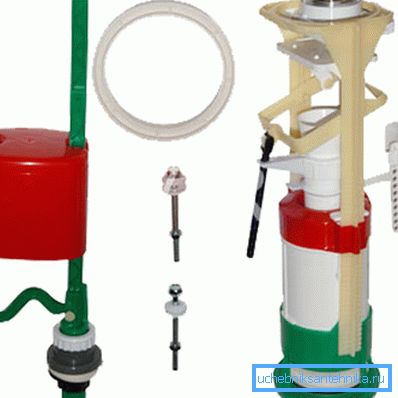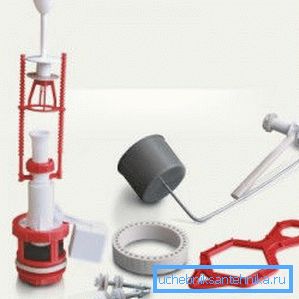Valve for cistern - types and methods of repair
Now it is difficult to imagine how people could live in a house without a toilet. But the bathroom today must be with the most modern equipment, otherwise ease of use and comfort do not get. In any bathroom toilet is given a central place. At the same time, the drainage mechanism is slightly different for different models, so special attention should be paid to the trigger device - the drain tank valve, which we will look at in more detail today.

Drain unit groups
There are only two types of toilet mechanisms that stand out depending on how they are brought into operation:
| Push | The second name - push-button, which can be drained:
Developed and the third type - with a stop function. It is equipped with one key, but the water may merge differently. For adjustment it is necessary to press the button several times. For example, the first pressing you open the water, and the second - blocking its descent. |
| Exhaust | They are also called stock. This is due to the fact that in order to bring the device into action, it is necessary to raise the stem upwards using a handle, after which the drain hole will open. Recently released new toilet model does not have such a system. |

Valve with float
Used to supply and release water.
Devices have the following varieties:
- Croydon valve - consists of a shell, a lever axis on the float, a seat and a piston, its price is the lowest. The lever moves perpendicularly, dragging the piston with it. The system is usually used in old drain tanks, which are extremely rare today.
- Valve with piston - equipped with a lever axis, which is fixed in a split cotter pin. The movement of the lever in the horizontal direction sets the piston in motion, which periodically touches the seat, which makes it possible to regulate the flow of water to the tank. At the end it has a seal, which, in contact with the saddle, blocks the flow of water. This valve model is widely distributed today.
- Diaphragm valve - instead of a gasket, a membrane made of rubber or silicone is used in the construction, which is displaced during the movement of the piston. Due to this, at the right time, it can block the incoming flow of water. This type of device is the newest and most modern, usually used in the latest models of cisterns. Below we will consider precisely its design features and the mechanism arrangement.

Modern toilet flush cistern valves
Advantages:
- The float diaphragm valve allows water to be quickly drawn into the tank.
- Noise or silent content depends on the quality of the selected fittings.
- With it, you can very quickly turn off the water, in contrast to previous models.
Among the shortcomings - the instruction requires for the normal operation of the device only a constant pressure in the water supply network. Its parameters should be 0.05-0.1 MPa. In addition, water purity plays a special role, otherwise the valve will quickly fail. Alas, but in most cases outside the city these conditions are often not obtained.

The next point that cannot be ignored is the quality of the locking and fittings. The material for manufacturing must be of high quality and no defects are allowed in its production, otherwise the period of use of products will be significantly reduced.
The device will have to be changed often, because repair in this case will not help. Make a new membrane with your own hands is unrealistic.

How the valve works
The inlet fittings of the tank have their own principle of work, with which it is necessary to figure out before you carry out work on its repair or replacement.
Below we consider the process in more detail.
- The first stage - the valve is open, and water begins to flow into the tank. In this case, the membrane under the action of the water flow moves aside and does not interfere with it. Only the preliminary compartment is filled. So that the water gets into the tank itself in the compartment made a special hole. The process of its mechanism is similar to the operation of devices equipped with valves with a rod, only with a membrane, stretched on the piston. It has a clearance for the passage of the plastic rod, which also has a clearance of O1 mm. Because of this, a small part of the water enters the filling compartment, which is formed by a piston and a membrane. When the float is lowered in the piston, an opening of O0.5 mm opens, through which some water can enter the tank. This allows you to provide the same pressure in the prefilling, filling compartments and behind the latter. In fact, this is the difference between the membrane and stem valve design.
- The second stage - the water enters the tank, raising the float up. At the same time, the level of the rod with rubber seal, which closes the hole, begins to increase. Further movement of the rod presses the piston and the membrane to the seat more, which is why the filling chamber is sealed. This is helped by the pressure of water. The membrane tightly pressed against the saddle, and the water stops flowing into the tank.
- The third stage - the descent of water. At this moment, the pressure of the float on the rod stops, which ceases to close the hole in the piston, due to which the pressure in the filling compartment begins to decrease. At this point, the water pressure displaces the membrane, and the operation of the tank enters the first stage.

Troubleshooting Mechanism
Water is not collected in the tank or does not overlap flow:
- This is usually due to clogging of any of the holes.
- The second option - the failure of the membrane or stock.
Tip: you need to disassemble the device and see all its elements that need to be cleaned and rinsed.
- Another reason for such malfunctions - low pressure in the plumbing system or its jumps during the day. Because of this, the device may also not work. (See also the article Pipes for plumbing in the apartment: features.)
If the pressure is too low, no water enters the tank at all. For example, in a suspended structure, it will not even reach the filling chamber. The float will pop up, but the flow will not block.

Tip: as an option - increase the water inlets, for which drill them 2-3 mm.
Note also that the smaller these openings, the greater the pressure in the system. Especially such knowledge will be useful when installing a toilet in the country. In the event of constant pressure surges, we recommend to purchase valves with a rod valve. (See also the article Connecting the toilet to the sewer: features.)
Conclusion
Today, the device was considered drain valve, which is used in the toilet bowl, the reasons for which the equipment may fail. With such knowledge, you can cope with these problems yourself. The video in this article will provide an opportunity to find additional information on the above topic.